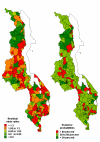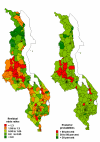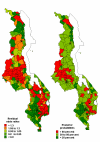Modelling the effect of malaria endemicity on spatial variations in childhood fever, diarrhoea and pneumonia in Malawi
- PMID: 17651488
- PMCID: PMC1963446
- DOI: 10.1186/1476-072X-6-33
Modelling the effect of malaria endemicity on spatial variations in childhood fever, diarrhoea and pneumonia in Malawi
Abstract
Background: Co-morbidity with conditions such as fever, diarrhoea and pneumonia is a common phenomenon in tropical Africa. However, little is known about geographical overlaps in these illnesses. Spatial modelling may improve our understanding of the epidemiology of the diseases for efficient and cost-effective control.
Methods: This study assessed subdistrict-specific spatial associations of the three conditions (fever, diarrhoea and pneumonia) in relation to malaria endemicity. We used data from the 2000 Malawi demographic and health survey which captured the history of childhood morbidities 2 weeks prior to the survey date. The disease status of each child in each area was the outcome of interest and was modelled using a trivariate logistic regression model, and incorporated random effects to measure spatial correlation.
Results: The risk of fever was positively associated with high and medium malaria endemicity levels relative to low endemicity level, while for diarrhoea and pneumonia we observed marginal positive association at high endemicity level relative to low endemicity level, controlling for confounding covariates and heterogeneity. A positive spatial correlation was found between fever and diarrhoea (r = 0.29); while weak associations were estimated between fever and pneumonia (r = 0.01); and between diarrhoea and pneumonia (r = 0.05). The proportion of structured spatial variation compared to unstructured variation was 0.67 (95% credible interval (CI): 0.31-0.91) for fever, 0.67 (95 % CI: 0.27-0.93) for diarrhoea, and 0.87 (95% CI: 0.62-0.96) for pneumonia.
Conclusion: The analysis suggests some similarities in subdistrict-specific spatial variation of childhood morbidities of fever, diarrhoea and pneumonia, and might be a result of shared and overlapping risk factors, one of which is malaria endemicity.
Figures




Similar articles
-
A Bayesian multinomial model to analyse spatial patterns of childhood co-morbidity in Malawi.Eur J Epidemiol. 2007;22(8):545-56. doi: 10.1007/s10654-007-9145-y. Epub 2007 Jun 13. Eur J Epidemiol. 2007. PMID: 17565446
-
An investigation of district spatial variations of childhood diarrhoea and fever morbidity in Malawi.Soc Sci Med. 2006 Mar;62(5):1138-52. doi: 10.1016/j.socscimed.2005.07.028. Epub 2005 Sep 1. Soc Sci Med. 2006. PMID: 16139938 Free PMC article.
-
Joint spatial modelling of common morbidities of childhood fever and diarrhoea in Malawi.Health Place. 2009 Mar;15(1):165-72. doi: 10.1016/j.healthplace.2008.03.009. Epub 2008 Apr 3. Health Place. 2009. PMID: 18486524
-
Folic acid supplementation and malaria susceptibility and severity among people taking antifolate antimalarial drugs in endemic areas.Cochrane Database Syst Rev. 2022 Feb 1;2(2022):CD014217. doi: 10.1002/14651858.CD014217. Cochrane Database Syst Rev. 2022. PMID: 36321557 Free PMC article.
-
Global burden of childhood pneumonia and diarrhoea.Lancet. 2013 Apr 20;381(9875):1405-1416. doi: 10.1016/S0140-6736(13)60222-6. Epub 2013 Apr 12. Lancet. 2013. PMID: 23582727 Free PMC article. Review.
Cited by
-
Comparing approaches for chemoprevention for school-based malaria control in Malawi: an open label, randomized, controlled clinical trial.EClinicalMedicine. 2024 Sep 16;76:102832. doi: 10.1016/j.eclinm.2024.102832. eCollection 2024 Oct. EClinicalMedicine. 2024. PMID: 39318787 Free PMC article.
-
Spatio - temporal modelling assessing the burden of malaria in affected low and middle-income countries: a scoping review.BMJ Open. 2018 Sep 5;8(9):e023071. doi: 10.1136/bmjopen-2018-023071. BMJ Open. 2018. PMID: 30185578 Free PMC article.
-
The Pattern of Variation between Diarrhea and Malaria Coexistence with Corresponding Risk Factors in, Chikhwawa, Malawi: A Bivariate Multilevel Analysis.Int J Environ Res Public Health. 2015 Jul 21;12(7):8526-41. doi: 10.3390/ijerph120708526. Int J Environ Res Public Health. 2015. PMID: 26197332 Free PMC article.
-
Addressing diarrhea prevalence in the West African Middle Belt: social and geographic dimensions in a case study for Benin.Int J Health Geogr. 2008 Apr 23;7:17. doi: 10.1186/1476-072X-7-17. Int J Health Geogr. 2008. PMID: 18433488 Free PMC article.
-
Utilization of insecticide-treated nets by under-five children in Nigeria: assessing progress towards the Abuja targets.Malar J. 2008 Jul 30;7:145. doi: 10.1186/1475-2875-7-145. Malar J. 2008. PMID: 18667077 Free PMC article.
References
Publication types
MeSH terms
Grants and funding
LinkOut - more resources
Full Text Sources
Medical

